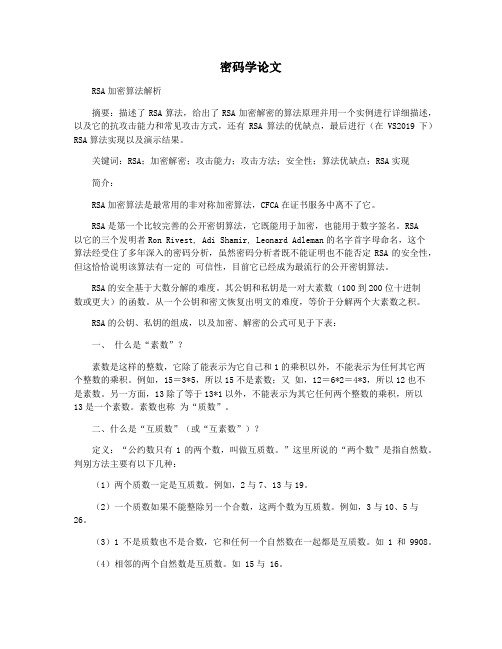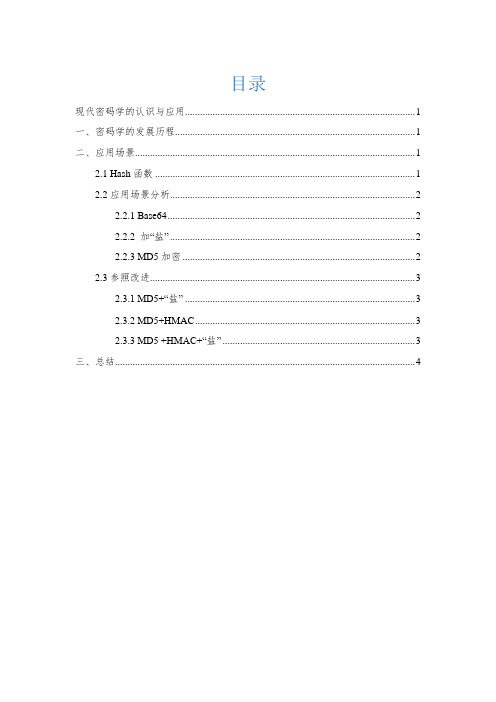现代密码学小论文
计算机加密论文3900字_计算机加密毕业论文范文模板

计算机加密论文3900字_计算机加密毕业论文范文模板计算机加密论文3900字(一):计算机网络安全中数据加密技术的应用论文摘要:互联网络改变了人们的生活方式和生活习惯,推动了科技经济的发展进程。
然而,计算机网络为我们供了便利的同时,也对网络数据的安全传输、储存工作构成了一定的威胁。
鉴于此,本文首先介绍了数据加密技术的基本概念,并简要分析了影响计算机网络安全的因素,并提出了数据加密技术在计算机网络安全中的应用对策,以期为我国网络加密技术贡献一点微薄的力量,促进我国互联网行业领域的健康发展。
关键词:计算机网络安全;数据加密技术;应用;探析在科学技术飞速发展的今天,数据加密技术逐渐成为了计算机信息数据发展的主流趋势,如何高效应用数据加密技术也成为了备受人们关注的热点问题。
计算机网络技术已经渗透到了人们工作、生活的方方面面,为人们带来了极大的便利条件。
数据加密技术可以对现有的网络数据进行整合、加密,并对数据的查看人员、接收人员进行严格的筛选和过滤,以此确保网络信息传输的安全度和精准度。
1、数据加密技术概述1.1数据加密技术的基本概念数据加密技术是针对互联网信息数据提出的一种现代化密码技术,其作用原理是通过安全密钥,将数据在明文、密文之间相互转化,以此实现对重要数据的保密传输工作。
首先,信息方需要先对数据设置加密函数,或通过在数据上添加密钥等方式,将需要被保护的数据转化为一种没有真实含义的密文,当对方成功接受密文之后,再使用相应的密钥和解密函数,将密文转回原本的明文。
在数据信息安全备受关注的今天,合理应用数据加密技术,可以有效防范不法分子、恶意操作人员对信息数据作出拦截、窃取、篡改等行为,消除了网络信息传输中的部分不安全因素,有助于营造安全、合理的网络信息环境。
1.2数据加密技术的分类根据作用原理、作用过程的不同,数据加密技术可大致分为以下两种类型:(1)存储加密技术:该技术利用密文对数据信息进行合理的储存,以此消除数据储存过程中不必要的安全隐患。
现代密码技术论文

湖南农业大学课程论文学院:信息科学技术学院班级:网络一班姓名:雷胜杰学号:************ 课程论文题目:现代密码技术发展及在密码安全中的应用课程名称:网络安全评阅成绩:评阅意见:成绩评定教师签名:日期:年月日摘要:如何保证数据安全,是当前信息领域亟待解决的突出问题,作为数据安全的基础和核心,密码技术及应用是信息发展的重中之重。
综合分析现代密码技术的发展,深入研究其在传统数据安全及云计算平台下的数据安全中发挥了巨大作用,为信息安全的持续发展奠定了基础。
关键词:数据安全现代密码技术防范建议引言:随着互联网的普及和信息网络建设的深入发展,信息安全的重要性也随之越来越显现出来。
信息化的高速发展使得信息的获取,共享和传播更加方便,同时也增加了敏感信息泄密的风险。
无论对于个人企业还是政府,计算机中最重要的是存储的数据,一旦丢失,将造成不可估量的损失。
2015年10月19日知名白帽子平台下午2时多突然发布公告,称接到一起惊人的数据泄密报告,网易的用户数据库疑似泄露,影响到网易163/126邮箱过亿数据,泄露信息包括用户名、MD5密码、密码密保信息、登录IP以及用户生日等,其中密码密保解开后测试大部分邮箱依旧还可登录。
黑吧安全网官微随后又发文称,这次密码泄露似乎也不是改密码就能解决这么简单,因为还泄露了用户密码提示问题及答案,而且这个数据应该是用其他网站泄露的账号密码“撞库”也无法获取的,因此建议大家“改密码的同时也将密码提示答案进行更新修改”。
这些事件都充分说明了数据安全问题已经成为一个迫在眉睫的问题,而保障数据安全最基本的方式就是利用密码技术,对敏感数据进行加密处理针对该问题,本文结合现代密码技术的发展,探讨密码技术在安全防护中的应用。
一.现代密码技术的发展:密码技术是信息安全技术的核心。
密码学包括密码编码学和密码分析学。
密码体制设计是密码编码学的主要内容,密码体制的破译是密码分析学的主要内容,密码编码技术和密码分析技术是相互依存,相互支持,密不可分的两个方面。
现代密码学论文(同名13947)

现代密码学课程论文学习︽现代密码学︾后的感受院系:数学与信息科学系班级:姓名:学号:对现代密码学的认识一、密码学的发展历程密码学在公元前400多年就早已经产生了,正如《破译者》一书中所说“人类使用密码的历史几乎与使用文字的时间一样长”。
密码学的起源的确要追溯到人类刚刚出现,并且尝试去学习如何通信的时候,为了确保他们的通信的机密,最先是有意识的使用一些简单的方法来加密信息,通过一些(密码)象形文字相互传达信息。
接着由于文字的出现和使用,确保通信的机密性就成为一种艺术,古代发明了不少加密信息和传达信息的方法。
例如我国古代的烽火就是一种传递军情的方法,再如古代的兵符就是用来传达信息的密令。
就连闯荡江湖的侠士,都有秘密的黑道行话,更何况是那些不堪忍受压迫义士在秘密起义前进行地下联络的暗语,这都促进了密码学的发展。
事实上,密码学真正成为科学是在19世纪末和20世纪初期,由于军事、数学、通讯等相关技术的发展,特别是两次世界大战中对军事信息保密传递和破获敌方信息的需求,密码学得到了空前的发展,并广泛的用于军事情报部门的决策。
例如在希特勒一上台时,德国就试验并使用了一种命名为“谜”的密码机,“谜”型机能产生220亿种不同的密钥组合,假如一个人日夜不停地工作,每分钟测试一种密钥的话,需要约4.2万年才能将所有的密钥可能组合试完,希特勒完全相信了这种密码机的安全性。
然而,英国获知了“谜”型机的密码原理,完成了一部针对“谜”型机的绰号叫“炸弹”的密码破译机,每秒钟可处理2000个字符,它几乎可以破译截获德国的所有情报。
后来又研制出一种每秒钟可处理5000个字符的“巨人”型密码破译机并投入使用,至此同盟国几乎掌握了德国纳粹的绝大多数军事秘密和机密,而德国军方却对此一无所知;太平洋战争中,美军成功破译了日本海军的密码机,读懂了日本舰队司令官山本五十六发给各指挥官的命令,在中途岛彻底击溃了日本海军,击毙了山本五十六,导致了太平洋战争的决定性转折。
数学在密码学中的应用浅析密码学论文写作范例论文(一)

数学在密码学中的应用浅析密码学论文写作范例论文(一)随着信息技术的发展,网络安全问题日益引起关注。
密码学作为信息安全领域中的一门基础学科,已经成为保护网络信息安全的一种重要手段。
而数学作为密码学的基础,更是不可或缺的一部分。
数学在密码学中的应用主要体现在加密算法、密钥的生成和数字签名等方面。
其中,加密算法是密码学中最基础的部分。
目前,对称加密和非对称加密是应用最广泛的两种加密方式。
对称加密就是指加密和解密使用同一个密钥的方式,非对称加密则是指加密和解密分别使用两个不同的密钥。
而这两种加密方式的安全性都与数学有着密不可分的关系。
对于对称加密,它主要是利用数学运算中的异或(XOR)和同或(XNOR)运算、置换和代换等操作,将明文转换为密文。
例如,DES(Data Encryption Standard)算法就是利用置换和代换操作实现加密的。
而非对称加密主要是利用数学中的大数因式分解和离散对数问题,如RSA 算法和椭圆曲线(Elliptic Curve)算法。
除了加密算法外,数学在密钥的生成和数字签名方面也有着重要的应用。
密钥的生成通常是指生成对称密钥和非对称密钥对的过程。
这个过程需要利用到数学中的大数质因数分解和离散对数问题,以确保生成出来的密钥安全可靠。
而数字签名则是通过数学中的哈希函数、公钥加密和私钥解密等方法,实现对数字文档进行签名认证的过程。
在写密码学论文的时候,我们需要清晰地阐述数学在密码学中的应用,并且采用恰当的数据陈述和相关例子来支撑我们的观点。
我们还需要关注密码学的发展历程和应用现状,以便为我们的论文提供足够的背景信息。
此外,我们可以从需求、流程、应用、安全等角度对密码学进行全面分析,从而更好地展示数学在密码学中的应用。
总之,数学在密码学中的应用不可忽视。
无论是对称加密还是非对称加密,都需要依靠数学的算法和理论来保证加密的安全性。
因此,了解数学在密码学中的应用是我们研究和保护信息安全的必要基础。
现代密码学论文-DES安全性分析

现代密码学论文姓名:学号:班级:指导老师:提交日期:DES安全性分析摘要:DES算法全称为Data Encryption Standard,即数据加密算法,它是IBM公司于1975年研究成功并公开发表的,是迄今为止世界上最为广泛使用和流行的一种分组密码算法.关键词:DES;安全性分析;密钥产生;加密解密DES算法全称为Data Encryption Standard,即数据加密算法,它是IBM公司于1975年研究成功并公开发表的,是迄今为止世界上最为广泛使用和流行的一种分组密码算法.DES算法的入口参数有三个:Key、Data、Mode.其中Key为8个字节共64位,是DES算法的工作密钥;Data也为8个字节64位,是要被加密或被解密的数据;Mode为DES的工作方式,有两种:加密或解密.DES加密算法框图DES算法把64位的明文输入块变为64位的密文输出块,它所使用的密钥也是64位,其算法主要分为两步:1初始置换编辑本段其功能是把输入的64位数据块按位重新组合,并把输出分为L0、R0两部分,每部分各长3 2位,其置换规则为将输入的第58位换到第一位,第50位换到第2位......依此类推,最后一位是原来的第7位.L0、R0则是换位输出后的两部分,L0是输出的左32位,R0是右32位,例:设置换前的输入值为D1D2D3......D64,则经过初始置换后的结果为:L0=D58D50......D8,R0=D57D49 (7)2逆置换编辑本段经过16次迭代运算后,得到L16、R16,将此作为输入,进行逆置换,逆置换正好是初始置换的逆运算,由此即得到密文输出. L0=D58D50......D8;R0=D57D49 (7)一、Feistel模型分析优点:1.设计容易:f 函数不要求可逆,加、脱密脱算法结构相同;2.强度高:如果f 函数是随机的,则连续若干圈复合形成的函数与随机置换是无法区分的.缺点:1.每圈加密时输入有一半没有改变;2.左右块的加密处理不能并行实施.Feistel模型实现完全性的性能分析如果对每个密钥k,迭代次数为m的加密变换Ek(x)的每个输入比特的变化都可能会影响到每个输出比特的变化,则称Ek(x)是完全的.意义: 实现了Shannon提出的扩散性原则.扩散原则(Diffusion):让明文中的每一位影响密文中的尽可能多的位,或者说让密文中的每一位都受到明文中的尽可能多位的影响.因为在检验完全性时,无法对所有的密钥都来检验影响的必然性, 只好退而求其次,来分析这种可能性.如果函数f是完全的, 当不考虑变换结果的抵消时,则无论改变x或y的一个比特, 第3圈的输出的左半和右半的每个比特都可能改变,这说明此时3圈能够实现完全性.二、DES的S盒的设计标准DES算法的设计者迫于公众压力公布的S盒的设计标准为:1. S盒的每一位输出都不是输入的线性或仿射函数.2. S盒的输入发生1比特变化,输出至少有2比特发生变化.3. 当固定S盒的1位输入时,S盒的每一位输出中0和1的个数尽可能平衡.DES的核心是S盒,S盒能够实现较好的“混淆”,S盒作为该密码体制的非线性组件对安全性至关重要。
【精品论文】探究基于交织法与现代密码学的加密技术(最新整理)

探究基于交织法与现代密码学的加密技术摘要:通讯领域以内,交织技术针对着成群错误,纠正这类偏差。
交织器打乱初始的输入次序,缩减了数值序列特有的彼此关联。
经过这种调整,突发错误附带着的危害即可减小。
这种打乱次序可被用来加密。
为此,有必要探析交织技术特有的根本机理,用于加密数值。
选取文本形态,整合了VB这一语言。
现代密码学架构下的组合加密融汇了分组流程、交织技术流程,广泛用来加密。
关键词:交织法;现代密码学;加密技术信息安全之中,密码学被划归核心。
现代特有的密码机制,包含私钥及对应着的公钥。
在这之中,私钥即为单钥,加密解密同一;公钥含有双钥,加密及后续的解密拟定了不同的路径。
这类便捷流程整合了数字签名、鉴别某一信息,用于商务金融。
依照现有要求,加密算法固有的范畴正被拓展,创设了新颖体制。
日常运用之中,密钥独有的安全特性被注重,变为流行体制。
现代密码学、交织法协同下的加密步骤凸显了优势,可以推广采纳。
1探析根本机理1.1针对交织技术在通信体系内,交织技术紧密关联着平日的数值处理,属于必要技术。
从根本上看,它在最大范畴内变更了固有的信息结构,但不改变内涵,这就是交织器。
信道传输之中,突发错误经由这类处理可被分散化,显出不规则化。
因此,数据错乱的这类装置吻合了交织器自带的本质。
在数值通信中,依照对象类别,交织器可被分成比特交织、常见符号交织。
依照交织方式,它显出了明晰的周期特性,包含了伪随机。
依照交织领域,它含有时间交织、对应的频率交织。
针对信息序列,在某一时点输出来某一信息,对应着信息位。
对于交织器,它预设了给定的某周期,即常规情形下的交织长度。
识别周期以后,交织器可被表征为某一替换矩阵。
在给定矩阵内,第一行凸显了固有的信息位;第二行表征着交织得出的新信息位。
这种置换被看成根本的,其他序列都经由叠加得出。
选取两个整数,如果符合表达,则双重的交织器拥有同一的效能。
针对各类编码,都可预设这样的矩阵;生成交织器时,也可用到矩阵。
密码学网络安全论文2篇

密码学网络安全论文2篇今天店铺就要跟大家分享下关于密码学网络安全论文有哪些~那么对此感兴趣的网友可以多来了解了解下。
下面就是具体内容密码学网络安全论文一:1. 引言随着国家网络信息化建设的飞速发展,越来越多的人通过Internet网络来学习与工作,但是,由于因特网的全球性,开放性。
无缝连通性,共享性和动态发展,任何人都可以自由的介入,使得人们在享受网络提供的更加开放的空间和丰富资源的同时,也面临着前所未有的网络安全的威胁。
愈演愈烈的黑客攻击事件以及非法信息的不断蔓延、网络病毒的爆发、邮件蠕虫的扩散,也给网络蒙上了阴影。
因此,网络安全问题已逐渐成为世人关注的社会问题。
2. 密码学的涵义和特点密码学是研究如何隐密地传递信息的学科。
在现代特别指对信息以及其传输的数学性研究,常被认为是数学和计算机科学的分支,和信息论也密切相关。
密码学的基本要素是加密算法和密钥管理,密码就是一组含有参数k的变换E。
设已知信息m,通过变换E得到密文c。
即c=Ek(m)这个过程称之为加密,参数k称为密钥。
不是所有含参数k的变换都可以作为密码,它的要求是计算Ek(m)不困难:而且若第三者不掌握密钥k,即使截获了密文c,他也无法从c恢复信息m。
从密文c恢复明文m的过程称之为解密。
解密算法D是加密算法E的逆运算,解密算法也是含参数k的变换。
密码体制从原理上可分为两大类,即单钥体制和双钥体制。
单钥体制的加密密钥k和解密密钥k相同,采用双钥体制的每个用户都有一对选定的密钥:一个是可以公开的,称为公钥;另一个则是秘密的,称为私钥。
3. 密码学如何促进网络安全(里面可包含几个小点)密码学是计算机网络安全的基础,计算机网络与分布式系统的安全包含两个主要内容:保密性――即防止非法地获悉数据;完整性――即防止非法地修改数据,要想解决这些问题,就需要用到现代密码学。
下面就为大家介绍密码学在网络安全中的常见应用。
3.1 对称加密方式对称密码算法有时又叫传统密码算法,就是加密密钥能够从解密密钥中推算出来,反过来也成立。
密码学论文(网络安全期末)

密码学是一门古老而深奥的学科,从古代的加密军书到如今的手机解锁,密码研究已有数千年的历史。
密码学也经历了从古典密码学到现代密码学的演变,虽然密码学的科技在不断地进步,古典密码的难度已经不足一提,但是古老的密码学思想奠定了密码学发展的基础,至今仍然被广泛使用。
密码学是信息安全的一门科学,密码技术是信息安全的核心,现代密码学所涉及的学科很广,包括信息论、概率论、数论、计算复杂性理论、近世代数、离散数学、代数几何学和数字逻辑等。
密码学主要包括两大分支,一是密码编码学,二是密码分析学。
密码学是对这两门分支学进行综合分析、系统研究的科学,是保护信息安全最主要的手段之一。
编码学与分析学是相互对立、相互依存,正是因为这种对立统一的关系,才推动了密码学自身的发展,下面将对这两门学科分别进行介绍。
1.密码编码学密码编码学是研究密码体制的设计的一门学问,主要内容是对信息进行编码密码,以实现对信息的加密。
密码编码技术的主要任务是寻求产生安全性高的有效密码算法和协议,以满足对消息进行加密或认证的要求。
2.密码分析学密码分析学是研究如何破解被加密信息的一门学问,即通过破译密码,来获取到所加密的信息。
经历了多个发展阶段。
密码分析技术的主要任务是破译密码或伪造认证信息,实现窃取机密信息或进行诈骗破坏活动。
密码学的基本思想是通过改变原有信息的顺序或者用不同的字母、数字、汉字等字符去替换原有字符,使原始信息变成混乱无章的乱码,保证了即使被非法获得信息后,也无法了解传送双方在信息中想表达的含义。
由于传送双方在事先进行了约定,接收方会根据某种规则,通过乱码来恢复出原始的信息含义。
伴随着信息科技不断地发展,现如今的密码学应用领域也不仅仅局限于信息的加密,也扩展到了对身份的识别和电子的认证等方面,比如日常所使用的手机指纹识别、解锁图案等,都属于密码学的范畴。
综上所述,密码学思想主要分为加密和解密两大部分,常用的方法有顺序法则和替代法则。
密码学论文

传统加密技术论文软件学院计算机科学与技术07999222李文龙网络信息的飞速发展给人类社会带来巨大的推动与冲击,同时也产生了网络系统安全问题。
计算机网络的安全问题越来越受到人们的重视。
密码技术是保护计算机信息安全的主要手段之一,使用密码技术可以保证信息的机密性,还可以保证信息的完整性和确定性,防止信息被篡改、伪造和假冒。
说道密码技术,以下先了解什么是加密技术。
加密技术包括两个元素:算法和密钥。
算法是将普通的文本(或者可以理解的信息)与一串数字(密钥)的结合,产生不可理解的密文的步骤,密钥是用来对数据进行编码和解码的一种算法。
在安全保密中,可通过适当的密钥加密技术和管理机制来保证网络的信息通讯安全。
密钥加密技术的密码体制分为对称密钥体制和非对称密钥体制两种。
相应地,对数据加密的技术分为两类,即对称加密(私人密钥加密)和非对称加密(公开密钥加密)。
对称加密以数据加密标准(DES,Data Encryption Standard)算法为典型代表,非对称加密通常以RSA(Rivest Shamir Ad1eman)算法为代表。
对称加密的加密密钥和解密密钥相同,而非对称加密的加密密钥和解密密钥不同,加密密钥可以公开而解密密钥需要保密。
对称密码是一种加密使用相同密钥的密码体制,也称为传统密码算法。
对称密码利用密钥和加密算法将明文变成密文。
运用相同的密钥和解密算法,而已从密文恢复出明文。
对密码的两种攻击方法是基于密码算法性质的密码分析和基于穷举密钥的穷举攻击。
传统对称密码(计算机出现前)使用代换和/或置换技术。
代换技术。
代换技术将明文元素(字符、比特)映射为密文元素,置换技术将明文元素的位置进行系统的置换。
转轮技术是计算机出现前使用代换技术的复杂硬件设备。
隐写技术是一种将秘密信息隐藏于其他更大信息中的一种技术,是得其他人无法区分它的存在或隐藏信息的内容。
传统经典加密主要采用了两种加密技术:替代技术和置换技术。
密码学论文(1)

密码学论文(1)密码学论文班级:统计学(金融数学方向)姓名:鲁亚婷学号:110444061密码学论文在我们的生活中有许多的秘密和隐私,我们不想让其他人知道,更不想让他们去广泛传播或者使用。
对于我们来说,这些私密是至关重要的,它记载了我们个人的重要信息,其他人不需要知道,也没有必要知道。
为了防止秘密泄露,我们当然就会设置密码,保护我们的信息安全。
更有甚者去设置密保,以防密码丢失后能够及时找回。
我们要为信息添加安全锁,设置密码,那么密码到底是干什么的呢?其实,密码就是为了防止未被允许进入的陌生人进入你的“账户”、“系统”等读写你的文件和数据。
很简单的理解,就和门要上锁一样,如果不上锁,那别人去你的家就和去自己的家一样了。
有此可知,密码在生活中的重要性。
“密码”一词对人们来说并不陌生,人们可以举出许多有关使用密码的例子。
如保密通信设备中使用“密码”,个人在银行取款使用“密码”,在计算机登录和屏幕保护中使用“密码”,开启保险箱使用“密码”,儿童玩电子游戏中使用“密码”等等。
这里指的是一种特定的暗号或口令字。
现代的密码已经比古代有了长远的发展,并逐渐形成一门科学,吸引着越来越多的人们为之奋斗。
从专业上来讲,密码是通信双方按约定的法则进行信息特殊变换的一种重要保密手段。
依照这些法则,变明文为密文,称为加密变换;变密文为明文,称为脱密变换。
密码在早期仅对文字或数码进行加、脱密变换,随着通信技术的发展,对语音、图像、数据等都可实施加、脱密变换。
为了研究密码所以就有了密码学。
密码学是研究编制密码和破译密码的技术科学。
研究密码变化的客观规律,应用于编制密码以保守通信秘密的,称为编码学;应用于破译密码以获取通信情报的,称为破译学,总称密码学。
密码学是在编码与破译的斗争实践中逐步发展起来的,并随着先进科学技术的应用,已成为一门综合性的尖端技术科学。
它与语言学、数学、电子学、声学、信息论、计算机科学等有着广泛而密切的联系。
密码学论文

信息技术安全——密码学摘要随着网络已经逐步进入我们的生活,网络安全也随之倍受人们的关注,而在网络安全中起着举足轻重作用的正是密码学,文中简单的介绍有关密码学的发展,较为详细的对密码学中极为经典的算法DES和RSA进行解释,通过对这两个算法的理解,来认识当今密码学发展的前沿和动向。
关键词密码学,非对称加密算法,对称加密算法,数字签名,Abstract the security of webnet has been paid more attention When Internet has been involving into our life .The cryptography play a important role in the security of webnet .In this article I will discuss the development of the cryptography and I will thorough interpret these two algorithm about DES and RSA. We will recognize the forward position and tendency about cryptography though understand those two algorithm.Key words Cryptography , No-symmetric encryption algorithm , symmetric encryption algorithm, the digital signature密码学的发展历程随着信息化和数字化社会的发展,人们对信息安全和保密的重要性认识不断提高,而在信息安全中起着举足轻重作用的密码学也就成为信息安全课程中不可或缺的重要部分,密码学早在公元前400多年就已经产生,正如《破译者》一书中所说的“人类使用密码的历史几乎与使用文字的时间一样长”。
密码学论文写作论文

密码学论⽂写作论⽂密码学论⽂写作范例论⽂ 随着⽹络空间竞争与对抗的⽇益尖锐复杂,安全问题以前所未有的深度与⼴度向传统领域延伸。
随着移动互联⽹、下⼀代互联⽹、物联⽹、云计算、命名数据⽹、⼤数据等为代表的新型⽹络形态及⽹络服务的兴起,安全需求⽅式已经由通信双⽅都是单⽤户向⾄少有⼀⽅是多⽤户的⽅式转变。
如果你想深⼊了解这⽅⾯的知识,可以看看以下密码学论⽂。
题⽬:数学在密码学中的应⽤浅析 摘要:密码学作为⼀门交叉学科,涉及学科⼴泛,其中应⽤数学占很⼤⽐例,其地位在密码学中也越来越重要,本⽂简单介绍密码学中涉及数学理论和⽅法计算的各种算法基本理论及应⽤,并将密码学的发展史分为现代密码学和传统密码学,列举⼆者具有代表性的明⽂加密⽅法,并分别对其中⼀种⽅法进⾏加密思想的概括和阐述。
关键词:密码学应⽤数学应⽤ 随着信息时代的⾼速发展,信息的安全越来越重要,⼩到个⼈信息,⼤到国家安全。
信息安全主要是将计算机系统和信息交流⽹络中的各种信息进⾏数学化的计算和处理,保护信息安全,⽽密码学在其中正是处于完成这些功能的技术核⼼。
在初期的学习当中,⾼等数学、线性代数、概率论等都是必须要学习的基础学科,但是涉及密码学的实际操作,数论和近世代数的'数学知识仍然会有不同程度的涉及和应⽤,本⽂在这⼀基础上,讨论密码学中⼀些基本理论的应⽤。
⼀、密码学的含义及特点 密码学是由于保密通信所需从⽽发展起来的⼀门科学,其保密通讯的接受过程如下:初始发送者将原始信息(明⽂)进⾏⼀定⽅式转换(加密)然后发送,接受者收到加密信息,进⾏还原解读(脱密) ,完成保密传输信息的所有过程,但是由于传输过程是经由有线电或⽆线电进⾏信息传输,易被窃取者在信息传输过程中窃取加密信息,在算法未知的情况下恢复信息原⽂,称为破译。
保密信息破译的好坏程度取决于破译者的技术及经验和加密算法的好坏。
实际运⽤的保密通信由两个重要⽅⾯构成:第⼀是已知明⽂,对原始信息进⾏加密处理,达到安全传输性的效果;第⼆是对截获的加密信息进⾏信息破译,获取有⽤信息。
现代密码学论文

现代密码学论文院(系)名称理学院专业班级计算131班学号********* 学生姓名王云英摘要现代密码学研究信息从发端到收端的安全传输和安全存储,是研究“知己知彼”的一门科学。
其核心是密码编码学和密码分析学。
前者致力于建立难以被敌方或对手攻破的安全密码体制,即“知己”,后者则力图破译敌方或对手已有的密码体制,即“知彼”。
人类有记载的通信密码始于公元前400年。
1881年世界上的第一个电话保密专利出现。
电报、无线电的发明使密码学成为通信领域中不可回避的研究课题。
现有的密码体制千千万万各不相同。
但是它们都可以分为私钥密码体制(如DES密码)和公钥密码(如公开密钥密码)。
前者的加密过程和脱密过程相同,而且所用的密钥也相同;后者,每个用户都有公开和秘密钥。
现代密码学是一门迅速发展的应用科学。
随着因特网的迅速普及,人们依靠它传送大量的信息,但是这些信息在网络上的传输都是公开的。
因此,对于关系到个人利益的信息必须经过加密之后才可以在网上传送,这将离不开现代密码技术。
PKI是一个用公钥概念与技术来实施和提供安全服务的具有普适性的安全基础设施。
PKI公钥基础设施的主要任务是在开放环境中为开放性业务提供数字签名服务。
现代密码学的算法研究密码算法主要分为对称密码算法和非对称密码算法两大类。
对称加密算法指加密密钥和解密密钥相同,或知道密钥之一很容易推导得到另一个密钥。
通常情况下,对称密钥加密算法的加\解密速度非常快,因此,这类算法适用于大批量数据的场合。
这类算法又分为分组密码和流密码两大类。
1.1 分组密码分组密码算法实际上就是密钥控制下,通过某个置换来实现对明文分组的加密变换。
为了保证密码算法的安全强度,对密码算法的要求如下。
1.分组长度足够大:当分组长度较小时,分组密码类似于古典的代替密码,它仍然保留了明文的统计信息,这种统计信息将给攻击者留下可乘之机,攻击者可以有效地穷举明文空间,得到密码变换本身。
2.密钥量足够大:分组密码的密钥所确定密码变换只是所有置换中极小一部分。
基于现代密码学的加密算法验证系统的设计与实现的论文

基于现代密码学的加密算法验证系统的设计与实现的论文摘要:针对现代密码学课程中理论与实践存在的差距,特意设计并开发了此款加密算法验证系统。
本系统以AES、RSA、RC4、IDEA等几个经典的加密算法为例,采用JAVA技术体系与SWING界面元素开发,保证跨平台性与良好的用户体验,通俗易懂地展示了现代密码学理论魅力。
本系统各个版块保持相对独立,每个版块侧重特定加密算法,提供一个以算法为基本模块的流程验证系统。
实践证明,使用此系统有利于学生深刻剖析算法原理过程,从而加深理论理解。
关键词:现代密码学;AES;RSA;RC4;IDEA;验证系统;EAVS1引言现代密码学理论是安全类本科专业极其重要的一门专业课,但由于密码理论本身的抽象性特点,导致教学过程中易出现理论与实践脱节,理论概念模棱两可的情况。
目前各个高校信息安全教学主要分为两个方向:一个是数学系的信息安全,主要研究密码学数学基础,偏重理论;二是计算机系的'信息安全,主要研究安全编程技术,偏重实践。
随着研究的深入,我们发现两者没有一个很好的平台联系起来,导致学生知识掌握不全面,不能适应工作和深层次科研的需求。
2密码算法的选择为了深入结合本科教学培养方案,特选取几个经典的加密算法:AES、RSA、RC4、IDEA。
2.1AES算法高级加密标准,又称高级加密标准Rijndael加密法,属于经典的现代加密算法,是美国联邦政府采用的一种区块加密标准。
由于此算法为对称加密算法,故通常用来加解密,用来替代原先的DES,已经被广泛使用。
AES很好地融合了混淆与扩散,因为信息的内容是以128位长度的分组为加密单元的。
加密密钥长度有128,192或256位等多种选择。
AES算法加密过程:密钥扩展→初始轮→重复轮→最终轮2.2RSA算法1977年Rivest,Shamir和Adleman提出了RSA公钥算法,它是应用最广泛的公钥密码系统。
不仅可以用于信息的加解密,还可用于数字签名。
密码学原理及应用的小论文

密码学原理及应用的小论文引言密码学是研究通信安全和信息安全的学科,它涉及到使用密码算法来保障数据的机密性、完整性和可用性。
随着互联网的快速发展,密码学变得越来越重要,它不仅应用于日常的网络通信,还广泛应用于金融、电子商务、军事等领域。
本文将介绍密码学的基本原理以及其在现实生活中的应用。
密码学的基本原理密码学的基本原理主要包括对称密码和非对称密码两种方式。
对称密码对称密码也称为私钥密码,它使用相同的密钥进行加密和解密。
发送方使用密钥对明文进行加密,并将密文传输给接收方,接收方再使用相同的密钥对密文进行解密。
常见的对称密码算法包括DES(Data Encryption Standard)、AES (Advanced Encryption Standard)等。
对称密码的优点是加解密速度快,适合对大量数据进行加密。
然而,由于发送和接收方需要共享同一个密钥,导致密钥管理变得困难,容易引发安全问题。
非对称密码非对称密码也称为公钥密码,它使用两个密钥:公钥和私钥。
发送方使用接收方的公钥对明文进行加密,并将密文传输给接收方。
接收方使用自己的私钥对密文进行解密。
常见的非对称密码算法包括RSA(Rivest-Shamir-Adleman)、DSA (Digital Signature Algorithm)等。
非对称密码的优点是密钥管理方便,安全性较高。
然而,加解密速度比对称密码慢,适合对少量数据进行加密。
密码学的应用网络通信安全网络通信安全是密码学应用的主要领域之一。
在网络通信中,不同的实体通过公网进行数据传输,为了保障数据的机密性和完整性,使用密码学进行加密是必要的。
例如,在网上购物中,消费者使用网银进行支付,需要通过密码学保障交易数据的安全性,防止被黑客篡改或窃取。
数字签名数字签名是密码学在数据完整性验证方面的一个重要应用。
使用私钥对数据进行签名,然后接收方使用发送方的公钥对签名进行验证。
如果验证通过,则说明数据完整且未被篡改。
密码学论文

密码学论文RSA加密算法解析摘要:描述了RSA算法,给出了RSA加密解密的算法原理并用一个实例进行详细描述,以及它的抗攻击能力和常见攻击方式,还有RSA算法的优缺点,最后进行(在VS2019下)RSA算法实现以及演示结果。
关键词:RSA;加密解密;攻击能力;攻击方法;安全性;算法优缺点;RSA实现简介:RSA加密算法是最常用的非对称加密算法,CFCA在证书服务中离不了它。
RSA是第一个比较完善的公开密钥算法,它既能用于加密,也能用于数字签名。
RSA以它的三个发明者Ron Rivest, Adi Shamir, Leonard Adleman的名字首字母命名,这个算法经受住了多年深入的密码分析,虽然密码分析者既不能证明也不能否定RSA的安全性,但这恰恰说明该算法有一定的可信性,目前它已经成为最流行的公开密钥算法。
RSA的安全基于大数分解的难度。
其公钥和私钥是一对大素数(100到200位十进制数或更大)的函数。
从一个公钥和密文恢复出明文的难度,等价于分解两个大素数之积。
RSA的公钥、私钥的组成,以及加密、解密的公式可见于下表:一、什么是“素数”?素数是这样的整数,它除了能表示为它自己和1的乘积以外,不能表示为任何其它两个整数的乘积。
例如,15=3*5,所以15不是素数;又如,12=6*2=4*3,所以12也不是素数。
另一方面,13除了等于13*1以外,不能表示为其它任何两个整数的乘积,所以13是一个素数。
素数也称为“质数”。
二、什么是“互质数”(或“互素数”)?定义:“公约数只有1的两个数,叫做互质数。
”这里所说的“两个数”是指自然数。
判别方法主要有以下几种:(1)两个质数一定是互质数。
例如,2与7、13与19。
(2)一个质数如果不能整除另一个合数,这两个数为互质数。
例如,3与10、5与26。
(3)1不是质数也不是合数,它和任何一个自然数在一起都是互质数。
如1和9908。
(4)相邻的两个自然数是互质数。
计算机密码技术论文(2)

计算机密码技术论文(2)计算机密码技术论文篇二密码安全防范相关技术在计算机密码保护中的应用研究摘要计算机中的密码保护主要是指使用适当的加密算法和加密密钥将明文信息转换为不可识别的密文信息进行存储和传输。
本文首先对计算机密码保护的意义和目的做了简要介绍,然后重点对加密安全防护实现与典型算法进行了分析,最后对如何做好密钥的管理与维护进行了讨论。
关键词计算机;密码保护;信息加密;密钥管理中图分类号:TP309 文献标识码:A 文章编号:1671-7597(2013)17-0080-01计算机是数字信息存储与传递的主要载体之一,随着计算机及计算机网络应用范围的拓展,数据信息特别是某些重要的、私密的数据信息的安全受到了多方面的威胁,为提升数据信息的安全性和可靠性必须使用加密技术对其进行重新编码以实现隐藏真实信息的目的。
对信息进行加密与解密需要使用到密钥,为进一步提升数据信息的安全性能,需要采用多种手段和技术来保证密钥安全,避免密钥信息泄露。
1 计算机信息加密技术概述对计算机存储和传输的数字信息进行加密主要是指利用适当的加密算法和加密密钥将明文信息转化为不可识别的、随机性较强的密文信息,而解密则是加密的逆过程。
对于同一组数据而言,加密与解密之间的转换是唯一的、可逆的。
对计算机信息进行加密保护主要出于以下几方面因素考虑。
1)提升数据信息的安全性,避免未授权用户获取、查看甚至是泄露用户的私密信息。
2)保证数据信息的完整性,避免非法用户对用户信息进行恶意篡改或删除。
3)防止特权用户利用管理特权或技术手段查看私人文件和相关信息。
随着计算机网络的普及,信息的获取渠道和途径越来越灵活,数据加密作为一种信息安全防护机制,对保护数据信息的安全与完整具有十分重要的意义。
2 常用的计算机加密技术根据加密与解密密钥的性质可以将目前所使用的计算机加密技术分为对称式加密和非对称式加密两类。
其中,对称式加密技术使用同一个密钥对数据信息进行加密与解密处理,非对称加密技术则分别使用公钥和私钥来对数据进行加密与解密。
现代密码学论文

Round-Optimal Password-Protected SecretSharing and T-PAKE in the Password-OnlyModelStanislaw Jarecki1,Aggelos Kiayias2,and Hugo Krawczyk31University of California Irvinestasio@2National and Kapodistrian University of Athensaggelos@3IBM Researchhugo@ee.technion.ac.ilAbstract.In a Password-Protected Secret Sharing(PPSS)scheme withparameters(t,n)(formalized by Bagherzandi et al.[2]),a user Alicestores secret information among n servers so that she can later recoverthe information solely on the basis of her password.The security require-ment is similar to a(t,n)-threshold secret sharing,i.e.,Alice can recoverher secret as long as she can communicate with t+1honest servers but anattacker gaining access to t servers cannot learn any information aboutthe secret.In particular,the system is secure against offline passwordattacks by an attacker controlling up to t servers.On the other hand,accounting for inevitable on-line attacks one allows the attacker an ad-vantage proportional to the fraction of dictionary passwords tested inon-line interactions with the user and servers.We present thefirst round-optimal PPSS scheme,requiring just one message from user to server and from server to user,and prove its se-curity in the challenging password-only setting where users do not haveaccess to an authenticated public key.The scheme uses an ObliviousPRF whose security we define using a UC-style ideal functionality forwhich we show concrete,truly practical realizations in the random oraclemodel as well as standard-model instantiations.As an important appli-cation we use this scheme to build thefirst single-round password-onlyThreshold-PAKE protocol in the CRS and ROM models for arbitrary(t,n)parameters with no PKI requirements for any party(clients orservers)and no inter-server communication.Our T-PAKE protocols arebuilt by combining suitable key exchange protocols on top of our PPSSschemes.We prove T-PAKE security via a generic composition theoremshowing the security of any such composed protocol.1IntroductionRemarkably,passwords have become a fundamental pillar of electronic security. That’s quite a high task for these low-entropy easily-memorable easily-guessed short character strings.In spite of repeated evidence of their vulnerability toP.Sarkar and T.Iwata(Eds.):ASIACRYPT2014,PART II,LNCS8874,pp.233–253,2014.c International Association for Cryptologic Research2014234S.Jarecki,A.Kiayias,and H.Krawczykmisuse and attack,passwords are still in widespread use and will probably remain as such for a long while.The portability of passwords makes them ubiquitous keys to access remote services,open computing devices,decrypt encryptedfiles, protectfinancial and medical information,etc.Replacing passwords with long keys requires storing these keys in devices that are not always available to the user and are themselves at risk of falling in adversarial hands,hence endangering these keys and the data they protect.An increasingly common solution to the problem of data security and avail-ability is to store the data itself,or at least the keys protecting its security,at a remote server,which in turn is accessed using a password.This requires full trust in this single server and the one password.In particular,compromising such a server(or just its passwordfile)is sufficient to crack most passwords stored at it through an off-line dictionary attack.Indeed,loss of millions of passwords to such attacks are common news nowadays[31].Unfortunately,off-line attacks are unavoidable in single-server scenarios.A natural approach to solving this prob-lem is to distribute the above trust over a set of servers,for example by sharing information among these servers using a secret sharing scheme.However,how does the user access these servers?Using the same password in each of these servers makes the off-line password recovery attack even worse(as it can be per-formed against any of these servers)while memorizing a different password for each server is impractical.PPSS.The above problem and a framework for solution is captured by the notion of Password-Protected Secret Sharing(PPSS),originated by the work of Ford and Kaliski[16]and Jablon[18]and formalized by Bagherzandi et al.[2]. In such a scheme,parametrized by(t,n),user Alice has some secret information sc that she wants to store and protect,and be able to later access on the basis of a single password pw.(Secret sc can represent any form of information,but it is best to think of it as a cryptographic key which protects some cryptographic capability.)The scheme has an initialization phase where Alice communicates with each one of a set of n servers S1,...,S n after which each server S i stores some informationωi associated with user Alice.When Alice needs to retrieve sc, she performs a reconstruction protocol by interacting with at least t+1servers where the only input from Alice is her password pw.The main requirements from this protocol are,informally:(i)an attacker breaking into t servers cannot gain any information on sc other than by correctly guessing Alice’s password and running an on-line attack with it(more on this below).It follows,in particular,that off-line attacks on the password are not possible as long as the attacker has not compromised more than t servers.In this case,the only avenue of attack against the secrecy of sc is for the attacker to select one value pw from a given dictionary D of passwords(from which the user has selected a password at random)and check its validity by interacting with the user and servers using pw as the password.If the overall number of interactions between the attacker and the user,and between the attacker and the servers,is q then we allow the attacker to break the semantic security of sc with advantage q/|D|.Moreover,we will require that“testing”a guessed passwordRound-Optimal Password-Protected Secret Sharing and T-PAKE235 by impersonating the user to the servers will require interacting with t+1 different servers.(ii)Soundness:Similarly,a compromise of up to t servers cannot allow an attacker to make the user reconstruct a wrong secret sc =sc,except with probability proportional to the number of on-line interactions between the attacker and the user.This is a necessary exception as the attacker can isolate the user and simulate a run with the servers with a password pw and secret sc chosen by the adversary;what’s required is that only if pw happens to be the user’s password will the attack succeed.Additionally,a desirable property is (iii)Robustness:Alice can correctly reconstruct sc as long as(a)no more than t servers are corrupted and(b)Alice communicates without disruptions with at least t+1honest servers.Note that robustness can only be achieved if2t+1≤n while the other properties do not impose such intrinsic limitation.T-PAKE.While PPSS schemes have many uses such as for retrieving keys, credentials,data,and so on,the main PPSS application is for bootstrapping a Threshold Password-Authenticated Key Exchange(T-PAKE)[27].In a(t,n)T-PAKE protocol,a user with a single password is to establish authenticated keys with any given subset of the n servers,such that security of the keys established with uncorrupted servers is guaranteed as long as there are no more than t corrupted servers.PPSS schemes make it possible to build T-PAKE protocols by combining the PPSS scheme with a regular key exchange protocol in a modular and generic way.This allows one to focus on the PPSS design which by virtue of being a much simpler primitive,e.g.,avoiding the intricacies of the security of(password)authenticated key exchange protocols,is likely to result in simpler and stronger solutions,as is indeed demonstrated by our results below.Prior/Concurrent Work and Our ContributionsFor the general case of(t,n)parameters,Bagherzandi et al.[2]showed a PPSS scheme in the random oracle model(ROM)where the reconstruction protocol involves three messages between the user and a subset of t+1servers(effectively 4messages in the typical case that the user initiates the interaction).However,if any of these servers deviates from the correct execution of the protocol,the pro-tocol needs to be re-run with a new subset of servers,which potentially increases the number of protocol rounds to O(n).Another significant shortcoming of the PPSS solution from[2]is that it is secure only in the PKI model,namely,where the user can authenticate the public keys of the servers.Indeed,if the attacker can induce the user to run the protocol on incorrect public keys,the protocol of [2]becomes completely insecure.Thus,[2]leaves at least two open questions:Do PPSS protocols with optimal single-round communication exist(i.e.,requiring a single message from user to server and single message from server to user),and can such protocols work in the password-only model,namely when the user does not have a guaranteed authentic public key.We answer both questions in the affirmative by exhibiting a PPSS protocol for a general(t,n)setting with optimal single-round communication(in ROM) which works in the password-only model.Concurrently to our work,Camenisch et al.[7]have also presented a general(t,n)setting PPSS which works in the236S.Jarecki,A.Kiayias,and H.Krawczykpassword-only model(and ROM).Their protocol sends10messages between the user and each server,its total communication complexity is O(t2),and the computational cost is more than7times the cost of our solution.Moreover,its robustness is fragile in the same way as that of[2],i.e.the user runs the recon-struction protocol with a chosen subset of t+1players,and the protocol must be re-started if any server in this chosen group deviates.By contrast,the protocol we present has2messages and O(n log n)(worst-case)communication complex-ity,which reduces to O(n)if the user caches O(n)data between reconstruction protocol instances.Our protocol also has stronger robustness guarantee,namely, Alice recovers her shared secret sc in the single protocol instance as long as it has unobstructed communication with at least t+1honest servers and if2t+1≤n. While[7]formalize a UC functionality for PPSS(which they call“TPASS”, for Threshold Password-Authenticated Secret Sharing)and prove their proto-col to realize this functionality,we model the security of a PPSS scheme in the password-only setting with a game-based notion.We show that our game-based security notion is strong enough to imply the security of a natural T-PAKE construction built on top of a PPSS scheme.However,a PPSS satisfying a UC formalization might simplify the use of PPSS in the design of other cryptographic schemes,which leaves designing a UC secure PPSS with low message complexity and good robustness as an interesting open question.Our PPSS construction is based on a novel version of so-called Oblivious Pseu-dorandom Function(OPRF)[17]and our contributions touch on three distinct elements,OPRF’s,PPSS,and T-PAKE’s,which we discuss next.OPRF.The basic building block of our PPSS construction is a Verifiable Obliv-ious PRF(V-OPRF).Oblivious PRF(OPRF)was defined[17,20]as a protocol between two parties,a server and a user,where thefirst holds the key k for a PRF function f while the latter holds an argument x on which f k(·)should be evaluated.At the end of the protocol the user learns f k(x)and is convinced that such value is properly evaluated while the server learns nothing.Formalizing the OPRF primitive in a way that can serve our application is not trivial.Indeed, the intuitive definition of OPRF[17,20]as the secure computation of a two-party functionality which on input pair(k,x)returns an output pair(⊥,f k(x)),is lim-iting for at least three reasons:(1)It does not imply security when several OPRF instances are executed concurrently,as is the case in our PPSS construction;(2) It does not apply to our setting where the existence of authenticated channels cannot be assumed;and(3)It is not clear how to instantiate such functionality in the concurrent setting without on-line extractable zero-knowledge proofs of knowledge,which would add a significant overhead to any OPRF instantiation.We overcome these issues via a novel formalization of the verifiable version of the OPRF primitive,V-OPRF,as an ideal functionality in the Universal Com-posability(UC)framework[10]for which we show several very efficient instan-tiations.Expressing V-OPRF in the UC framework is a delicate task,especially in the setting of interest to us where there are no authenticated channels.Our formalism enforces that the server who generates the PRF key k also produces a function descriptorπ,whichfixes a deterministic function fπ.(For honestRound-Optimal Password-Protected Secret Sharing and T-PAKE237 servers,πis a commitment to k and thefixed function fπis equal to the PRF f k.)Then,in any(non-rejecting)execution of the V-OPRF protocol executed given the function descriptorπ,the V-OPRF functionality verifies that the user’s output is computed as fπ(x).In other words,the V-OPRF functionality ensures consistency between V-OPRF instances executed under the same function de-scriptorπas well as verifiability that the output value is computed using the committed function fπ.Our UC V-OPRF formalization bears interesting similarities to UC blind signatures[25,15,1].In a nutshell,instead of on-line extraction of argument x from the(potentially malicious)client in every V-OPRF instance,a V-OPRF functionality issues a ticket for every instance executed under a given descriptor π.The user(or adversary)can then use these tickets to evaluate function fπon inputs of their choice,but with the constraint that m tickets cannot be used to compute fπvalues on more than m distinct inputs.Given this similarity,we observe that an efficient realization of V-OPRF can be achieved(in ROM)by hashing a deterministic blind signature-message pair.We obtain three highly efficient variants of this design strategy,which provide three single-round V-OPRF instantiations in ROM,and we prove them UC-secure under“one-more”type of assumptions[3,21].Specifically,we show such V-OPRF instantiations in ROM under a one-more Gap DH assumption on any group of prime order,a similar assumption on the group with a bilinear map, and a one-more RSA assumption.We also provide an efficient standard model V-OPRF construction for the Naor-Reingold PRF[30],based on the honest-but-curious OPRF protocol given by[17].This protocol has four messages and is secure under Strong-RSA and the Decisional Composite Residuosity(DCR) assumptions.A single round standard-model(CRS)protocol is possible too but at a significant higher computational complexity.We note that the UC formalization of the Verifiable Oblivious PRF function-ality that is at the core of our security treatment is likely to have applications beyond this work.Indeed,OPRF’s have been shown to be useful in a variety of scenarios,including Searchable Symmetric Encryption(SSE)schemes,e.g. [13,11],and secure two-party computation of Set Intersection[17,20,21]. PPSS.Our PPSS protocol is password-only in the Common Reference String (CRS)model,i.e.the user needs no other inputs than her password and a CRS string defining a non-malleable commitment scheme instance which can be part of the user’s V-OPRF software.Our PPSS protocol is single-round in the hybrid model where parties can access the V-OPRF functionality.Given the V-OPRF instantiations discussed above,this implies three different instantiations of a single-round(i.e.two-message)PPSS schemes in ROM based on different one-more type of assumptions,and a four-message PPSS scheme in the CRS model.Our PPSS construction follows the strategy of the early protocols of Ford and Kaliski[16]and Jablon[18]who treated the case of t=n:Secret-share the secret sc into shares(s1,...,s n),let each server S i pick key k i for a PRF f,andlet c=(e1,...,e n)where e i is an encryption of s i underρi=f ki (pw).Eachserver S i stores(k i,c),and in the reconstruction protocol the user re-computes238S.Jarecki,A.Kiayias,and H.Krawczykeachρi via an instance of a V-OPRF protocol with each server S i on its input pw and S i’s input k i.If the user also gets string c from the servers,the user can decrypt shares s i using theρi’s and interpolate these shares to reconstruct sc.Thefirst thing to note is that ciphertexts e i must not be committing to the encryption keyρi.Otherwise,an adversary could test a password guess pw∗in an interaction with a single V-OPRF instance(instead of requiring t+1 interactions with t+1different servers as our security notion imposes on theattacker),by computingρ∗i=f ki (pw∗)and testing if decryption of e i underρ∗ireturns a plausible share value.We prevent such tests by sharing sc over a binary extensionfield F=GF(2 ),choosing a PRF f which maps onto -bit strings, and setting e i to s i⊕f k i(pw).Secondly,the above simple protocol can allow a malicious server S i tofind the user’s password pw if S i is not forced to usethe same function fπi in each V-OPRF instance.Consider the OPRF protocolof[17]for the Naor-Reingold PRF f ki (x)=g v where v=k i,0·x j=1k i,jfor k i=(k i,0,...,k i, )[30].If in some PPSS instance,a misbehaving S i uses key k i which differs from k i on one index j,i.e.in one component k i,j,S i can conclude that the j-th bit of pw is0if the user recovers its secret correctly from such PPSS instance.Note that the adversary can learn whether user’s secret is reconstructed correctly by observing any higher-level protocol which uses this secret,e.g.a T-PAKE protocol discussed below.We counter this attack by using the verifiability property of our V-OPRF functionality,which ensures that S i computes the function committed inπi,and by extending the user-related information stored by each server toω=(π,c,C)whereπis a vector of function descriptorsπ1,...,πn of each server,and C is a non-malleable commitment to the valuesπ,c and user’s password pw.This commitment is the basis for ensuring that the on-line attacker playing the role of the servers can test at most one password guess per one reconstruction protocol instance.Note that the described solution requires O(n)storage and bandwidth per server,but it is straightforward to reduce these to O(log n)using a Merkle tree commitment.With an instantiation of V-OPRF in ROM we achieve a remarkably efficient reconstruction protocol without relying on PKI or secure channels.The user runs an optimal2-message protocol with t+1(or more)servers,and in the case of our V-OPRF construction based on the one-more Gap DH assumption,the protocol involves just2exponentiations by the server and a total of2t+3multi-exponentiations for the user,employing the optimized ROM-based NIZK for discrete logarithm equality of[12],plus a few inexpensive operations.The(one-time)initialization stage is also very efficient,involving2n+1exponentiations for the user and3exponentiations per each server.Note that there is no inter-server communication in the protocol and that the user can communicate with each server independently,so it can be done in parallel and/or in any order without the servers being aware of each other.Moreover,the user can initiate the V-OPRF protocol with more than t+1servers,and it will reconstruct secret sc as long as t+1contacted servers reply with correct tripleω=(π,c,C)and complete the V-OPRF instances on function descriptorsπi inπ.Round-Optimal Password-Protected Secret Sharing and T-PAKE239 Our PPSS protocol in the password-only setting enjoys the following security hedging property:While avoiding the need to rely on the authenticity of servers’public keys held by the user is an important security property,when such public keys are available they can add significant security,because they render on-line attacks against a user ineffective and strengthen the security and the soundness properties of the PPSS scheme.Thus,to get the benefits of both worlds,both with and without the correctly functioning PKI,running a password-only PPSS protocol over PKI-authenticated links achieves the following:If the user has the correct servers’public keys,she gets the additional security benefits stated above,otherwise,if some or all of the public keys are either incorrect or missing, she still enjoys the security of the password-only setting.T-PAKE.When composed with regular key exchange protocols,our PPSS scheme leads to the most efficient T-PAKE protocols to date even when com-pared to protocols that assume that the user carries a public key that it can use to authenticate the servers.Figure1summarizes the state of the art in T-PAKE protocols and how our protocols compare to this prior work.Interestingly,while there is a large body of work on single-server PAKE protocols(e.g.[4,23,24,5]) that has produced remarkable schemes,including one-round password-only pro-tocols in the standard model,threshold PAKE has seen less progress,with most protocols showing disadvantages over a single-server PAKE.In particular,be-fore our work,no single-round(t,n)-PAKE protocol was known,not even in the ROM and assuming PKI.Most protocols assume a public key carried by the client(making them non password-only)and all assume secure channels(or PKI)between servers.Even in the n=t=2case no one-round protocol was known,and all previously known protocols for this case require inter-server se-cure channels.Our work improves on these parameters achieving the best known properties in all the aspects reflected in the table.In particular,we achieve single-round password-only protocol in the CRS and ROM models for arbitrary(t,n)parameters with no PKI requirements for any party and no inter-server communication(secure communication is only assumed when a userfirst registers with the servers).In addition,the protocol is com-putationally very efficient(and more so than any of the previous protocols, even for the(2,2)case).We also exhibit a password-only standard-model imple-mentation of our scheme requiring two rounds of communication(4messages in total)between client and servers.Our T-PAKE protocols are built by combining (existing)suitable key exchange protocols on top of our V-OPRF-based PPSS scheme.We prove T-PAKE security via a generic composition theorem showing the security of any such composed protocol.Organization.In Section2we present the formalization of the V-OPRF func-tionality in the UC setting.In Section3we show an efficient realization of this functionality in the random oracle model(ROM)(further ROM and standard (CRS)model constructions are presented in the full version[19]).In Section4 we define and formalize PPSS in the password-only model.In Section5we present an efficient PPSS realization which relies on the V-OPRF functionality. Finally,in Section6we consider T-PAKE schemes obtained by composing a240S.Jarecki,A.Kiayias,and H.Krawczykscheme(t+1,n)ROM/std client inter-server msgs total p.C|S BJKS[6](2,2)ROM PKI PKI7O(1)O(1) KMTG[22](2,2)Std/ROM CRS sec.chan.≥5O(1)O(1)CLN[9](2,2)Std/ROM CRS PKI8O(1)O(1)DRG[14]t<n/3Std CRS sec.chan.≥12O(n3)O(1)|O(n2) MSJ[27]any ROM PKI PKI7O(n2)O(1)|O(n) BJSL[2]any ROM PKI PKI3O(t)8t+17|16 CLLN[7]any ROM CRS PKI10O(t2)14t+24|7t+28 Our PPSS1any ROM CRS none2O(t log n)2t+3|2Our PPSS2any Std CRS none4O( t log n)O(t )|O(l) parison between PPSS/T-PAKE schemes.“PPSS1”and“PPSS2”refer to our PPSS scheme of Section5with V-OPRF instantiated,respectively,with protocol 2HashDH-NIZK of Section3(this instantiation is shown in Figure5)and with proto-col NR-V-OPRF(deferred to the full version[19]).The“total comm.”column counts the number of transmitted group elements and other objects of length polynomial in the security parameter,like public-key signatures.Variable denotes the length of the password string(or its hash).The last column counts(multi)exponentiations in a prime-order group(except for our PPSS2where exponentiations are modulo a Paillier modulus)performed by the client and each server in the reconstruction protocol.All costs in the last four rows refer to an optimistic scenario with no adversarial interfer-ence.With worst-case adversarial interference,for BJSL and CLLN all costs grow by the factor of n−t,while for our schemes costs grow by the factor of n/(t+1) .PPSS scheme with a regular key-exchange protocol,and present a full specifi-cation of our most efficient instantiation of the PPSS and T-PAKE protocols. This version of the paper omits many details,constructions and proofs;please refer to the full version[19]for a complete presentation.2Functionality F VOPRFThe F VOPRF functionality can be thought of as a collection of tables that are indexed by“labels”denoted by the function parametersπ.Users may obtain val-ues from these tables on inputs x of their choice without leaking any information about these inputs(and corresponding outputs)to the adversary.F VOPRF gen-erates these tables dynamically andfills them with random values on demand. Each table is associated by the functionality with a specific sender.In addition to the tables registered to honest senders,the adversary is allowed to register with F VOPRF its own tables.Interacting with an adversary-registered table does not jeopardize the privacy of the user’s input but naturally F VOPRF will provide no pseudorandomness guarantee for the output derived from such tables.How-ever,F VOPRF will ensure that all adversarial tables are completely determined according to a deterministic function that is committed by the adversary at the time of the table’s initialization in the form of a circuit M.Round-Optimal Password-Protected Secret Sharing and T-PAKE241Functionality F VOPRFKey generation:On message(KeyGen,sid)from S,forward(KeyGen,sid,S)to adversary A∗.On message(Parameter,sid,S,π,M)from A∗,ignore this call if param(S)is already defined.Otherwise,set param(S)= π and initialize tickets(π)=0,and hist(π)to the empty string.If S is honest send(Parameter,sid,π)to party S, else parse M as a circuit with -bit output and insert(π,M)in CorParams.V-OPRF evaluation:On message(Eval,sid,S,x)from party U for sender S,record(U,x)and for-ward(Eval,sid,U,S)to A∗.On message(SenderComplete,sid,S)from A∗for some honest S output (SenderComplete,sid)to party S and set tickets(π)=tickets(π)+1forπs.t. π =param(S).On message(UserComplete,sid,U,π,flag)from A∗,recover(U,x)and:–Ifflag= and π =param(S)for an honest S then:If tickets(π)≤0 ignore the UserComplete request of A∗.Otherwise:(1)if hist(π)includesa pair x,ρ ,setρ=ρ ,else sampleρat random from{0,1} and enterx,ρ into hist(π);(2)Set tickets(π)=tickets(π)−1and output(Eval,π,ρ)to party U.–Else,ifflag=⊥then return(Eval,π,⊥)to U.–Else,ifflag= andπis such that(π,M)∈CorParams for some circuit M, computeρ=M(x),enter x,ρ in hist(π),output(Eval,π,ρ)to party U.Fig.2.Verifiable Oblivious PRF functionality F VOPRFA major consideration in our definition of F VOPRF is to avoid the need for input extractability(from dishonest users)in the real-world realizations of the functionality.Such need is common in UC-defined functionalities but in our case it would disqualify the more efficient instantiations of F VOPRF presented here.Thus,instead of resorting to input extraction requirements,we define a “ticket mechanism”that increases a ticket upon function evaluation at a sender and decreases it when this value is computed at the user(or the adversary). The functionality guarantees that tickets remain non-negative,namely,for any function parameterπregistered with a honest sender S,the number of inputs on which users compute the functionπis no more than the number of evaluations of the function at S.Another important aspect of our F VOPRF formalism is the way we handle the1-1relationship between a sender S and its function parameterπ,where S is used to identify a sender andπdescribes this sender’s committed function. The unique sender-function binding that is known to the functionality cannot be enforced in a real-world setting where users cannot validate such a binding as is the case when no authenticated channels(or other forms of authenticated information)are available to the user.Since these settings are common in our applications,we define F VOPRF so that the user can provide a name of a sender。
密码学教学实践应用分析论文(共6篇)

密码学教学实践应用分析论文(共6篇)本文从网络收集而来,上传到平台为了帮到更多的人,如果您需要使用本文档,请点击下载按钮下载本文档(有偿下载),另外祝您生活愉快,工作顺利,万事如意!第1篇:浅析密码学在信息安全中的应用随着人们生活水平的快速提高和现代电子信息技术的发展,互联网开始走进千家万户,不断改变着人们的生活和工作方式。
与此同时,也给人们的个人信息和隐私带来了极大的安全隐患。
相关的恶性事件也多次被新闻媒体曝光,对网络信息安全提出了巨大的挑战。
因此,密码学逐渐被业内人士发现并进行深入研究后,被广泛应用到网络信息安全中来,以确保网络信息达到真正意义上的安全。
1密码学技术主要的分类加密技术使确保网络信息安全的重要手段,工作原理就是将网络信息转化为密文,然后通过网络突进进行传送,即使被不法分子捕获,也无法识别其中的有效信息,在输出时,再将信息转化为人们交流使用的明文。
通过这种方式来确保网络信息的安全。
加密目前有两种主要的分类即专用密钥加密和非对称加密。
专用密钥加密或对称加密方法专用密钥加密或对称加密主要的特点就是加密密钥和解密密钥是同一种密钥,大大简化了对信息加密的过程。
传输双方要想获得有用的信息只需要共享就可以得到,不需要再进行交换彼此的算法[1]。
但是这种方法有一定的缺陷,就是在信息传输过程中无法识别信息的发起方和信息的最终方,而且只能是一一对应的映射方式。
专用密钥加密的密钥总共是56位,在传统的DES 加密技术的基础上,进一步优化改进成三重DES,大大加大了信息的安全性。
并且RCZ和RC4加密技术也逐渐被广泛应用,这种算法的密钥长度是可以改变的,可以根据不同的情况使用不同长度的密钥。
非对称加密或公共密钥加密方法在加密过程中,密钥被进一步分解成一对密钥,这一对密钥中的任何一个密钥都可以作为公开的密钥被大量使用,但是为确保信息安全必须把另外一把密钥保存起来,由一方单独掌握。
非对称密钥常用的加密方法就是RSA算法,它有一个明显的缺点就是运算的速度非常的缓慢[2]。
现代密码学小论文

目录现代密码学的认识与应用 (1)一、密码学的发展历程 (1)二、应用场景 (1)2.1 Hash函数 (1)2.2应用场景分析 (2)2.2.1 Base64 (2)2.2.2 加“盐” (2)2.2.3 MD5加密 (2)2.3参照改进 (3)2.3.1 MD5+“盐” (3)2.3.2 MD5+HMAC (3)2.3.3 MD5 +HMAC+“盐” (3)三、总结 (4)现代密码学的认识与应用一、密码学的发展历程密码学的起源的确要追溯到人类刚刚出现,并且尝试去学习如何通信的时候,为了确保他们的通信的机密,最先是有意识的使用一些简单的方法来加密信息,通过一些(密码)象形文字相互传达信息。
接着由于文字的出现和使用,确保通信的机密性就成为一种艺术,古代发明了不少加密信息和传达信息的方法。
事实上,密码学真正成为科学是在19世纪末和20世纪初期,由于军事、数学、通讯等相关技术的发展,特别是两次世界大战中对军事信息保密传递和破获敌方信息的需求,密码学得到了空前的发展,并广泛的用于军事情报部门的决策。
20世纪60年代计算机与通信系统的迅猛发展,促使人们开始考虑如何通过计算机和通信网络安全地完成各项事务,从而使得密码技术开始广泛应用于民间,也进一步促进了密码技术的迅猛发展。
二、应用场景2.1 Hash函数Hash函数(也称杂凑函数、散列函数)就是把任意长的输入消息串变化成固定长度的输出“0”、“1”串的函数,输出“0”、“1”串被称为该消息的Hash值(或杂凑值)。
一个比较安全的Hash函数应该至少满足以下几个条件:●输出串长度至少为128比特,以抵抗攻击。
对每一个给定的输入,计算Hash值很容易(Hash算法的运行效率通常都很高)。
●对给定的Hash函数,已知Hash值,得到相应的输入消息串(求逆)是计算上不可行的。
●对给定的Hash函数和一个随机选择的消息,找到另一个与该消息不同的消息使得它们Hash值相同(第二原像攻击)是计算上不可行的。
- 1、下载文档前请自行甄别文档内容的完整性,平台不提供额外的编辑、内容补充、找答案等附加服务。
- 2、"仅部分预览"的文档,不可在线预览部分如存在完整性等问题,可反馈申请退款(可完整预览的文档不适用该条件!)。
- 3、如文档侵犯您的权益,请联系客服反馈,我们会尽快为您处理(人工客服工作时间:9:00-18:30)。
目录
现代密码学的认识与应用 (1)
一、密码学的发展历程 (1)
二、应用场景 (1)
2.1 Hash函数 (1)
2.2应用场景分析 (2)
2.2.1 Base64 (2)
2.2.2 加“盐” (2)
2.2.3 MD5加密 (2)
2.3参照改进 (3)
2.3.1 MD5+“盐” (3)
2.3.2 MD5+HMAC (3)
2.3.3 MD5 +HMAC+“盐” (3)
三、总结 (4)
现代密码学的认识与应用
一、密码学的发展历程
密码学的起源的确要追溯到人类刚刚出现,并且尝试去学习如何通信的时候,为了确保他们的通信的机密,最先是有意识的使用一些简单的方法来加密信息,通过一些(密码)象形文字相互传达信息。
接着由于文字的出现和使用,确保通信的机密性就成为一种艺术,古代发明了不少加密信息和传达信息的方法。
事实上,密码学真正成为科学是在19世纪末和20世纪初期,由于军事、数学、通讯等相关技术的发展,特别是两次世界大战中对军事信息保密传递和破获敌方信息的需求,密码学得到了空前的发展,并广泛的用于军事情报部门的决策。
20世纪60年代计算机与通信系统的迅猛发展,促使人们开始考虑如何通过计算机和通信网络安全地完成各项事务,从而使得密码技术开始广泛应用于民间,也进一步促进了密码技术的迅猛发展。
二、应用场景
2.1 Hash函数
Hash函数(也称杂凑函数、散列函数)就是把任意长的输入消息串变化成固定长度的输出“0”、“1”串的函数,输出“0”、“1”串被称为该消息的Hash值(或杂凑值)。
一个比较安全的Hash函数应该至少满足以下几个条件:
●输出串长度至少为128比特,以抵抗攻击。
对每一个给定的输入,计算
Hash值很容易(Hash算法的运行效率通常都很高)。
●对给定的Hash函数,已知Hash值,得到相应的输入消息串(求逆)是计
算上不可行的。
●对给定的Hash函数和一个随机选择的消息,找到另一个与该消息不同的
消息使得它们Hash值相同(第二原像攻击)是计算上不可行的。
●对给定的Hash函数,找到两个不同的输入消息串使得它们的Hash值相同
(即碰撞攻击)实际计算上是不可行的Hash函数主要用于消息认证算法
构造、口令保护、比特承诺协议、随机数生成和数字签名算法中。
Hash函数算法有很多,最著名的主要有MD系列和SHA系列,一直以来,对于这些算法的安全性分析结果没有很大突破,这给了人们足够的信心相信它们是足够安全的,并被广泛应用于网络通信协议当中。
2004年,中国密码学家王小云教授和她的团队将MD4的碰撞攻击复杂度时间降到手工可计算;并将寻找MD5算法实际碰撞的复杂度和SHA-1算法碰撞的理论复杂度分别降为239和263。
NESSIE工程推荐使用的Hash算法有
SHA-256/384/512和Whirlpool,日本密码研究与评估委员会推荐使用的算法有SHA-1/256/384/512、RIPEMD-160。
ECRYPT也在Hash算法研究方面举办了一系列活动。
2.2应用场景分析
随着计算机技术的飞速发展,计算机系统已经深入到社会的各个角落,极大的满足了用户的需求,提高了用户的办公效率,同时,也给用户信息安全提出了新的挑战。
在实际应用开发中,最直接的最基础的安全问题就是用户密码等信息的保存与保密。
常用的加密手段:
2.2.1 Base64
Base64加密算法,是网络上使用最广泛的一种编码格式,其编码原则为:将明文ASCII码转换为二进制以后,从左向右开始,每次取六个数字,转换为十进制后对照其索引表,找到相应的密文,一起进行编码,最后不足6位的全部补上0,编码完成以后的密文包括:A~Z,a~z,0-9和“+”“/”,同时最后补上零,每两个零被转换成“=”。
该方法运算简单,但是其密文可靠性较低,很容易被反编码的到相应的明文。
2.2.2 加“盐”
上面刚刚提到的Base64编码中,由于其可逆性导致在密码传递过程中的低可靠性,因此,出现一个补救措施:加“盐”。
这里的“盐”,就是干扰项。
在具体的应用中,在明文前后加上指定的“盐”,增大破解的难度。
但是具有规律可观察性。
2.2.3 MD5加密
MD5加密是Hash函数的一种典型应用,应用场景很广泛,上面已经提到,在这就不做具体赘述。
一般的应用中,我们常常只是用MD5对用户重要信息进行加密(比如密码),由于MD5加密的健壮性相对较高,所以该方法被认定为有效可靠的。
最近学习过程中发现一个网站(),该网站收录了160T 的MD5特征码,对简单MD5特征码的破纪录可以达到90%以上(未具体论证
其准确性)。
因此,淡出的MD5加密已经无法满足信息保密的需求。
还有一种常用的加密方法就是SHA算法,他与MD5算法具有同样的问题,在此不做赘述。
2.3参照改进
2.3.1 MD5+“盐”
上面已经提到,一个比较常用加密手段就是加“盐”,同时要求盐的复杂度和长度要达到一定的要求。
对于一般的应用场景,该方法已经基本可以胜任,国内一些公司就是才用的这种方法进行加密。
不过,我注意到在网站中也提供了对“加盐”特征码的破解,但是需要收费,具体的论证没有做,但是做了小测试:对于短的简单的“盐”很容易破解,长的复杂的“盐”破解成功率不太高。
2.3.2 MD5+HMAC
HMAC本身也是一种加密算法,他是基于SHA算法实现的。
单纯的使用HMAC也可以通过上进行解密。
因此,可以使用MD5+HMAC方法进行加密,该方法采用两次加密,在一定程度上保障了信息的安全性,但是对于长文本,性能上会受到一定的影响,不过对于密码的加密来说,已经足够了(其实归根结底只是形式上的变化,没有达到方法创新的层面,如果找到一定规律,也是可以慢慢破解的)。
2.3.3 MD5 +HMAC+“盐”
该方法是一种大杂烩形式的解决方法,但个人感觉应该是一种比较靠谱的解决方法。
该方法中的关键其实是“盐”的定义。
一般比较好的加盐方式是利用时间戳。
将时间戳作为“盐”的好处就是用户每次登陆得到的密码密文都是不相同的,在服务器端解析中,动态生成“两”个密码(详细解释见下图),而且一次请求的密码有效期是一分钟(其实按照网络请求过程中时间限定的相关原则,一般1分钟是网络请求等待时间的极限,超过一分钟的请求一般会被丢包(可设定,只是个人理解)或者用户就会重新请求),给相应的破译提高了一定的难度。
同时该方法在一定程度上也兼顾了实时性和运算效率的平衡。
对于进一步的安全措施,我们可以采用一些辅助手段,在上图中也写到了,如:ip记录、短信验证等。
不做赘述,一般的应用中,上面第三种方法已经可以胜任。
而至于辅助手段,不可以说没有意义,但是在一定程度上,是对用户个人信息的采集(如手机验证,个人感觉就是对个人信息的采集,并不能起到实时保护的作用,只是事后的一个通知补救措施)。
三、总结
通过现代密码学课程的学习,我对密码学的构成、主流加密算法和各个算法的基本算法有了全新的理解。
现代密码学是一个充满神秘性的学科,现代密码学是一个充满神秘性的学科,他是以计算机科学的发展为背景,数学思想为根本的一个交叉学科,因此密码学归根结底是数学问题,要想深入透彻的进行密码学相关的理论研究,我们需要有扎实的数学功底和广泛的兴趣爱好。
现代密码学中涉及的数学有:数论、近世代数、矩阵论、域论,以及其它结合较为紧密地理论:信息论、编码论、量子学、混沌论。
与之对应了一些前沿的密码学研究:在线/离线密码学、圆锥曲线密码学和代理密码学等。
因此,对密码学感兴趣的话,在后学的学习过程中,可以朝着这些方向努力。
